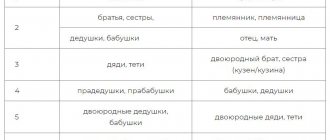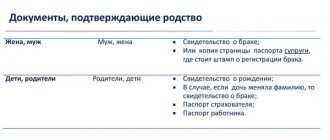Author of the article: Anastasia Ivanova Last modified: January 2021 21703
It is worth considering that the concept of family ties can be regarded not only as a social category; this definition plays a significant role in the legal aspect. The fact is that, based on family and civil legislation, a whole list of powers and obligations arises precisely from family ties. Most often, the range of relationships between certain individuals is established depending on the degree of relationship that occurs.
Theory
Initially, I would like to note that today there are two forms of kinship:
- Blood.
- Not bloody.
Relatives may be on the father's or mother's side. These are blood. Non-bloods are those who enter into family ties after marriage - through a husband or wife. I would also like to note that this list was larger before. They also distinguished agrarian or communal kinship, based on the management of a common household, as well as spiritual, which was also called fictitious or artificial.
Other blood relatives
The pattern of family ties is not limited to this. So, there are many more blood relatives who also have their correct names:
- First cousins are children born to the sister or brother of one of the parents. In the old days, such people were called bro, or brother, and also sister, or sister.
- Second cousins are grand-brothers or sisters.
- Nephews are the children of siblings, and great-nephews are the grandchildren of a brother or sister. There is also the concept of great-great-cousin, etc.
Acquired relatives
It is imperative to consider family ties (who is related to whom) after the wedding ceremony. This is where confusion most often arises.
- The wife's parents are usually called father-in-law and mother-in-law, and the husband's parents are father-in-law and mother-in-law.
- Parental pairs of married children are called matchmakers.
- In relation to parents: the bride is a daughter-in-law for her mother-in-law and a daughter-in-law for her father-in-law; The groom is a son-in-law for both mother-in-law and father-in-law.
- The bride's husband's brother is the brother-in-law. If a brother has a wife, she is a sex worker, or a yatrovka.
- If the husband has a sister, she will be the bride's sister-in-law.
- In the case where the wife has a sister, the groom will have her as a sister-in-law, and her husband as a brother-in-law. All men whose wives are related to each other are brothers-in-law.
- The wife's brother will be the brother-in-law. If a brother has a son, it is customary to call him Shurich.
It should be noted that family ties between people are the most important element in the life of every family. Today, unfortunately, people are increasingly beginning to forget that the only people who will always help are relatives. That is why these names have recently been lost. After all, relatives communicate with each other less and less. And, accordingly, they forget who is related to whom.
What are kinship ties
Kinship relations are social relations between people that arise from the fact of the origin of one individual from another, as well as several individuals from one ancestor.
By degree, close and distant kinship are distinguished, and by the presence of kinship ties, direct and indirect. It should be noted that regarding direct family ties, a direct ascending line of kinship and, accordingly, a descending line are distinguished separately.
From a legal point of view, only legally established connections matter. In other words, even if people are related to each other, such connections will entail the mutual emergence of rights and obligations between them not in all cases, but only when this is established by law.
In this case, it is difficult to overestimate the concept of family, kinship and property, their legal and judicial significance, because many rights and responsibilities are directly related to the presence of family relations. For example, parental responsibilities stem from the fact of paternity or maternity, and legal relations of inheritance stem from the fact of kinship with the testator.
In legal terms, it is important to clearly understand whether relatives are close or not. Therefore, when the question arises whether the list of close relatives in family law is exhaustive or not, one should be guided by the relevant provisions of the Family Code of the Russian Federation.
Blood or just close relatives?
Family ties and relationships do not end there. There are many different situations in life that are also important to take into account. For example, if a man has a second marriage, but still has children from the previous one.
- If the father remarries, then his new wife becomes a stepmother for the children. In a similar situation, however, if the children remained with their mother, and she found a new man, the kids acquire a stepfather.
- Children among themselves in this case are called stepchildren. Half-brothers, sisters.
- In relation to children: a son who is not his own is called a stepson, a step-daughter is called a stepdaughter.
If we talk about adopted children, they are considered named (named son or named daughter). The same applies to parents: the named father or mother.
It should also be noted that a family connection also arises if the parents do not live in an official marriage. They are popularly called a common-law married couple. In this case, children are considered relatives; they are not considered illegitimate. They don't have a special name.
Non-family relationships
Relationships during the second (and subsequent) marriage
- Half-brother, half-sister - children who have the same father, but different mothers.
- Half-brother, half-sister - children who have the same mother, but different fathers.
- Half-brother, half-sister - children from the first marriages of persons in relation to each other, that is, not relatives, not half-blooded or half-uterine, but only “brought together” into one family.
- A stepfather is a man in relation to his wife’s child born in another marriage, the mother’s husband, but not his own father.
- A stepmother is a woman in relation to her husband’s child born in another marriage, the father’s wife, but not his own mother.
- A stepson is a male representative in relation to the partner of his parent in another marriage, a step-son of a husband or wife.
- A stepdaughter is a female representative in relation to the partner of her parent in another marriage, a stepdaughter of her husband or wife.
Relationships upon adoption or loss of parents
- A foster child is an adopted child. Foster daughter (adopted) is a female person in relation to her adoptive parents (adopters).
- Adopted son (adopted) is a male person in relation to his adoptive parents (adoptive parents).
Spiritual Relationships
- A godfather (godfather) is a man in relation to the one for whose spiritual education he is responsible, that is, in relation to the godson. Godfather is the godfather in relation to the parents of the godson and the godmother, and also a successor. The child's father in relation to the godfather and godmother.
- Kuma is the godmother in relation to the parents of the godson and the godfather, and also the godfather. The child's mother in relation to the godfather and godmother.
Biological connections
- Donor is a person who gives his or her blood, tissue, cells or organ for transplantation into other people.
- Recipient - a person who receives a transplant of any organ, tissue or cells of another organism.
- A milk mother (mother, wet nurse) is a woman who fed someone else’s child with her own breast, in relation to this child. A foster brother is a boy/male in relation to a person with whom he was breastfed by the same woman, but who is not a sister or brother on the mother's side.
- A milk sister is a girl/woman in relation to a person with whom they were breastfed by the same woman, but who is not a maternal sister or brother.
Individual status
- A bachelor is a man who is not married, an unmarried man. A bobyl is usually the youngest child in a family who remains single to look after his parents and run their family trade. In addition, in the 15th-18th centuries, bobyls were the name given to bankrupt peasants who were unable to bear state duties - see Bobyl.
- An old maid , a bobyliha is a woman who has never been married, whose marriage is not expected due to her age or personal characteristics.
- A straw widow is a man who lives for a long time separately from his wife for a reason that depends on her.
- A straw widow is a woman who lives separately from her husband for a long time for a reason that depends on him.
- An orphan is a child whose both parents have died.
Other
- Uncle , mother (mother), nanny (nanny) - a person (man or woman, respectively) assigned to care and supervise a child.
- Kunak (Turkic) - among the Caucasian highlanders - a person associated with someone by an obligation of mutual hospitality, friendship and protection; friend, buddy.
- Named brother, named sister - a person who is not biologically related to this person, but who has agreed to a brotherly (sisterly) relationship voluntarily. Typically such agreements are bilateral.
Baptism
The Christian faith also presupposes the presence of godparents. Who are they? So, in the old days the mortality rate was much higher than in the modern world. And people, wanting to protect their children from poverty and wanderings, chose close relatives or good people who were the children’s godparents. They underwent a special church ceremony and subsequently bore responsibility for the life and fate of the child. Ideally, godparents should not only give gifts to children, but also visit occasionally. Their main purpose is the spiritual education of children named before God, instilling in them the norms and dogmas of Christianity. If the parents died, godparents, one of their godparents, took them in to raise and support the children. In financial terms, in this case, they were equally responsible for the child.
Today this is a little forgotten, but the names of such relatives remain:
- Godmother and father are the spiritual parents of the child.
- A godson or goddaughter is a child who has been baptized by an adult before God.
- There is also the concept of godsisters and brothers, natural children of godmothers and fathers.
- Kumovya (godfather, godfather) - blood and godparents among themselves.
Wedding kinship
Few people know, but family ties also arise during the wedding of young people. And if everything is clear about parents, family and a young couple, there are also indirect relatives.
- Friend and boyar. Today they are also called witnesses. They play a certain role not only in the wedding ceremony itself, but also during the wedding party.
- Tysyatsky. Today it is the toastmaster. Previously, he was a wedding manager who was responsible for everything that happened. Most often this is a godfather or an adult relative.
- Honorary brothers are men, friends of the groom, who pour alcoholic drinks and keep order.
So, we have considered almost all family ties. Who is related to whom? The diagram shows this too. In addition, you need to take into account all connections, both blood and non-blood.
When is a DNA test required?
If it is not possible to establish a relationship between the person concerned and another person based on documents, then there is a need to conduct a DNA test. This type of medical expert research helps to establish the presence or absence of blood ties between certain individuals.
The following can be used as DNA testing material:
- blood;
- hair, nails;
- seminal fluid;
- saliva;
- earwax;
- epithelial cells.







